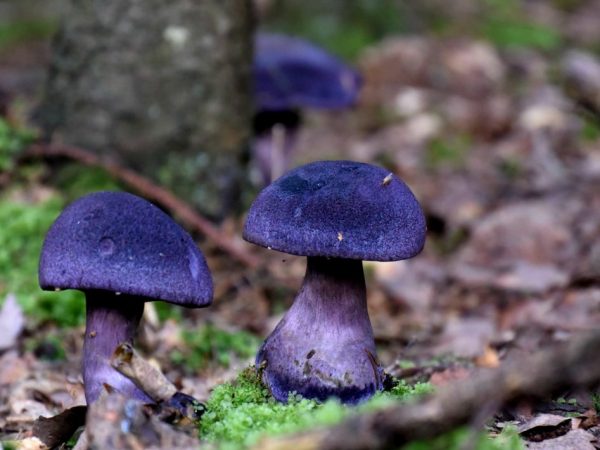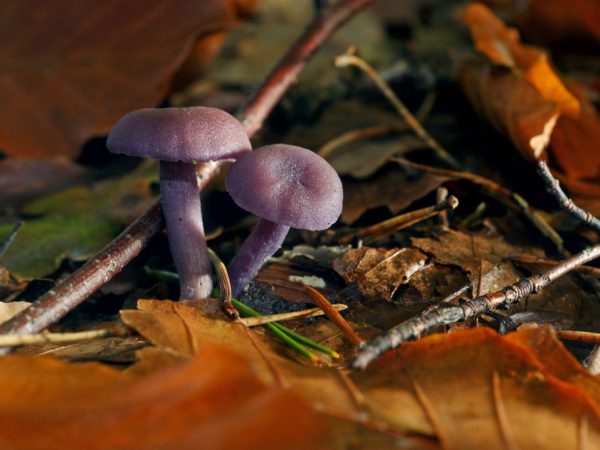Purple spiderweb mushroom
Fungi are a special group of living organisms that do not belong to either the plant or the animal world. They are distinguished by special qualities. One of them - a purple webcap - is included in the Red Book of Russia.

Purple spiderweb mushroom
Appearance
A beautiful, little-known to a wide range of mushroom pickers and edible purple spiderweb (Cortinarius Violaceus), a representative of agaric mushrooms, included in the Spiderweb family and the Spiderweb genus, grows in the deciduous and coniferous forests of Austria, England, Denmark, Czech Republic, Ukraine and Italy. Less common in Georgia, Japan and the United States.
Irina Selyutina (Biologist):
- It got its name due to the presence of a private coverlet on the cap, which resembles a cobweb in its structure and serves to create optimal conditions for the development of spores.
- Outwardly, this mushroom is somewhat reminiscent of a champignon painted in an unusual color.
- To its taste, the spider web resembles a nut.
- The cobweb cover disappears as the fungus grows.
- The purple webcap forms mycorrhiza with oaks, birches and beeches.
- The webcap is used to create environmentally friendly paints.
- This species is characterized by the presence of slow-acting toxins, therefore, the allergic response may be delayed from eating mushrooms by 2 weeks.
In the Russian Federation, it is found in the Murmansk, Leningrad, Moscow regions and the Primorsky Territory.
Description of the mushroom:
- cap diameter up to 16 cm;
- the shape of the cap is flat or hemispherical;
- the edge of the cap is lowered;
- the color of the cap is purple;
- the pulp is blue;
- weak aroma;
- the leg is thickened downwards.
Representatives of the species have a not pronounced aroma and a fragile purple pulp, pleasant to the touch. The older the cobweb is purple, the more saturated its color, but the color of the pulp, on the contrary, fades to white.
The leg of the purple spider web is cylindrical, in the upper part it is covered with small scales. The coloration of the stem is usually brownish or purple. The hymenophore plates are blue in color, but the spores formed on their surface are rusty-brown in color.
The size of the spores is 10-16 by 7-9 microns. Their shape is almond-shaped, rust-colored. Spore powder of ocher-brown color. The plates are rare.
Related species
The rare purple spiderweb mushroom has several related species, among which the most common are:
- Webcap white and lilac: cap up to 10-12 cm in diameter. It is connected by its edges to the leg. The brown flesh is pleasant to the taste, with a characteristic aroma.
- Scaly webcap: this species is characterized by a cap size of up to 9-10 cm in diameter. It is convex and covered with a layer of mucus, shiny with a bright aroma and taste.
- Cobweb yellow: has several more names: triumphal or yellow pribolotnik. Differs in the color of the cap according to the name. The taste is dim.
Useful properties and composition

The fungus will protect against viruses
Forest mushrooms, including cobwebs, contain many useful substances that the human body needs for normal life: fiber, which is necessary for building cells, trace elements and vitamins.
The biochemical composition of the purple webcap includes:
- vitamins B1, B2;
- zinc;
- copper;
- manganese;
- ergosterol (provitamin D2, the main sterol of fungi);
- stearic acid;
- chitin.
This rare mushroom actively supports the immune system and normalizes the functioning of the gastrointestinal tract. In case of fatigue, it promotes rapid recovery of strength. During infectious epidemics, it serves as the body's defense against viruses and bacteria.
Contraindications
This mushroom, like everyone else, absorbs into itself (into the fruiting and vegetative body) toxins from the external environment, air, and especially from the soil, into which chemical substances get into the environment with rains - released into the environment by industrial enterprises, cars, etc. Poisons accumulate in it, like in a sponge, and are poorly removed when processed at home, so it is better not to collect forest organisms close to roads, to residential areas and factories.
It is contraindicated to eat pregnant and lactating women without consulting a doctor and children under 14 years of age.
For people suffering from gastrointestinal diseases, eating will exacerbate the disease. The chitin in the leg slows down the digestion of food, which can cause the process of putrefaction in the stomach.
In addition to well-known complications, there are:
- Acute interstitial nephritis: inflammation of the kidneys, destruction of kidney tissue, which can manifest itself in sinusitis, angina.
- Allergic reaction.
- Increased bladder tone: leads to frequent urge to urinate, leaching of calcium from the bones.
- Toxic shock.
- Metabolic disorders (metabolic processes).
Application
The webcap is used for various purposes: in cooking, in pharmaceuticals.
Pharmaceutical applications
Interesting facts and information about its use in pharmaceuticals: violaceus cortinarius is used to create antibiotics and antifungal agents, it quickly lowers blood glucose levels, it is used in drugs to control hypoglycemia. It also has an anti-inflammatory effect and activates the immune system.
Cooking applications
Culinary experts prefer not to use the purple cobweb in hot dishes and snacks. This is due to the fact that the mushroom is rare and low-aromatic. It is better to pickle or pickle it.
- Before pickling, wash the mushroom well, remove the top and boil in salted water for at least 40 minutes.
- Drain and salt the water in which they were cooked according to a familiar and familiar recipe.
- For pickling, use vinegar, sunflower oil, salt and pepper. Place the harvested crop in a suitable container, add all the ingredients for the marinade and wait until the liquid comes out.
- Wash the prepared jars, put the mushrooms in them and sterilize for 15 minutes. Then close and store in a cool, dark place. The shelf life is no more than 1 year.
Conclusion
Gathering a crop in the forest, you should carefully approach your choice, take only those species that do not arouse suspicion. In the genus of cobwebs, there are more than 40 species, among which there are many poisonous, but similar to edible ones. The desire to pluck a rare organism must be combined with a reasonable approach.



